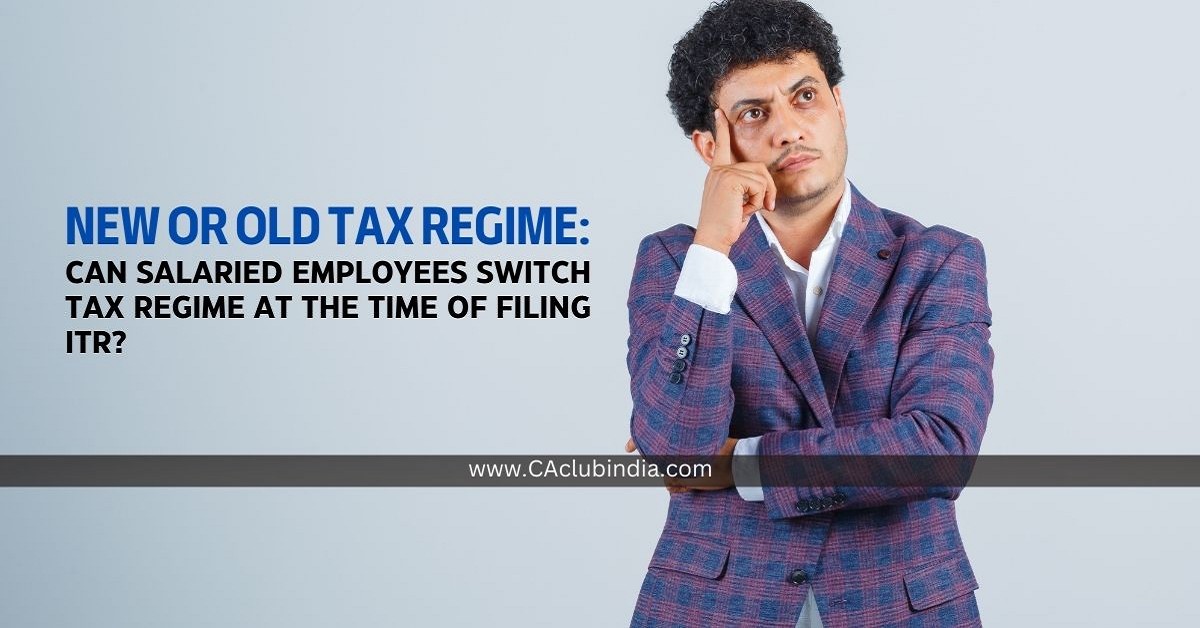Introduction
Filing income tax returns (ITR) is an annual responsibility for every salaried employee. But with the introduction of the new tax regime, taxpayers now have a choice: stick to the old system with deductions and exemptions or switch to the simplified new one. The big question that arises is: Can salaried employees switch their tax regime while filing ITR?
Imagine choosing between two roads on your financial journey-one full of turns and stops (old regime with exemptions) and the other a straight expressway (new regime with lower rates but fewer benefits). The choice may seem confusing, but the good news is that you do have some flexibility.
This article will explain how to switch old or new tax regime, the rules, the benefits, and the process in a simple, engaging way.

Table of Contents
| Sr# | Headings |
| 1 | Understanding Old vs New Tax Regime |
| 2 | Why Did the Government Introduce the New Tax Regime? |
| 3 | Key Features of the Old Tax Regime |
| 4 | Key Features of the New Tax Regime |
| 5 | Can Salaried Employees Switch Tax Regimes at Filing Time? |
| 6 | Rules for Switching Tax Regimes |
| 7 | Difference Between Salaried and Business Professionals in Switching |
| 8 | Process: How to Switch Old or New Tax Regime While Filing ITR |
| 9 | Which Tax Regime is Better for You? |
| 10 | Advantages of the Old Tax Regime |
| 11 | Advantages of the New Tax Regime |
| 12 | Common Mistakes People Make While Switching Tax Regimes |
| 13 | Practical Examples of Switching Regimes |
| 14 | Expert Tips for Choosing the Right Regime |
| 15 | Final Thoughts and Conclusion |
Understanding Old vs New Tax Regime
The old tax regime is what we have been using for decades. It offers multiple deductions and exemptions such as HRA, LTA, Section 80C, 80D, and more. The new tax regime, introduced in Budget 2020, comes with lower tax rates but very few deductions.
So essentially, the old regime rewards tax planning, while the new regime favours simplicity.
Why Did the Government Introduce the New Tax Regime?
The government wanted to make tax filing simpler. Many people don't invest in tax-saving instruments, so they can't benefit from deductions. The new regime was introduced as a "no-strings-attached" option-lower rates, but fewer complexities.
Key Features of the Old Tax Regime
- Multiple deductions under Section 80C (like LIC, PF, ELSS, tuition fees, etc.).
- Exemptions like HRA, LTA, and standard deduction.
- Higher effective savings if you are willing to plan investments.
Think of it as a buffet meal-you pay more, but you get more variety.
Key Features of the New Tax Regime
- Lower tax rates for most income slabs.
- No complicated deductions to claim.
- Simple to calculate and file.
It's like a combo meal-fewer items but at a cheaper price.
Can Salaried Employees Switch Tax Regimes at Filing Time?
Yes! Salaried employees can choose between the old and new regimes every year at the time of filing their ITR. If you feel the old regime benefits you more this year, go with it. If the new one saves more, you can switch.
This flexibility gives salaried employees the advantage of testing both regimes year after year.
Rules for Switching Tax Regimes
- Salaried employees can switch every year while filing ITR.
- Business professionals can switch only once. After that, they are locked into their choice.
- You must clearly select the regime in the ITR form.
Difference Between Salaried and Business Professionals in Switching
- Salaried: Can change every year.
- Business/Professionals: Can change only once in a lifetime.
This is because businesses have more complex tax planning compared to salaried individuals.
Process: How to Switch Old or New Tax Regime While Filing ITR
- Log in to the income tax e-filing portal.
- Select ITR Form (ITR-1 or ITR-2 for salaried employees).
- While filling the form, choose between "Old Regime" or "New Regime" under the relevant section.
- Verify and submit your return.
That's it! It's as simple as ticking a box.
Which Tax Regime is Better for You?
There's no one-size-fits-all answer. If you have multiple deductions like home loan interest, 80C investments, and insurance, the old regime may save more tax. If you don't have many deductions, the new regime might be better.
Advantages of the Old Tax Regime
- Better for those who invest in tax-saving schemes.
- Useful for people paying high rent (HRA benefits).
- Encourages disciplined financial planning.
Advantages of the New Tax Regime
- Lower tax rates for most salaried classes.
- Hassle-free filing process.
- No need to worry about saving just for tax benefits.
Common Mistakes People Make While Switching Tax Regimes
- Not calculating both regimes before choosing.
- Forgetting to declare deductions in the old regime.
- Assuming the new regime is always better just because it has lower rates.
Practical Examples of Switching Regimes
- Example 1: A salaried employee with high investments (₹1.5 lakh under 80C, home loan interest, and HRA) will benefit from the old regime.
- Example 2: A young professional with no investments and living with parents may save more under the new regime.
Expert Tips for Choosing the Right Regime
- Always compare tax liability under both regimes before filing.
- Consider your long-term financial goals.
- Don't just think about tax savings; think about overall financial health.
Final Thoughts and Conclusion
To sum up, salaried employees have the freedom to switch between old and new tax regimes each year while filing ITR. The choice depends on your financial situation, deductions, and lifestyle.
Think of it as choosing between tea and coffee-sometimes you prefer one, sometimes the other. What matters is that you have the flexibility.
So, before filing your next return, take a few minutes to calculate and then decide. That small effort could save you thousands of rupees.
FAQs
Can I switch between old and new tax regimes every year?
Yes, salaried employees can switch every year while filing ITR.
Do I need to inform my employer if I want to change the regime?
Not necessarily. You can directly choose the regime while filing your ITR.
Can business professionals switch regimes like salaried employees?
No, they can switch only once. After that, they are locked into their choice.
Is the new regime always better for young employees?
Not always. It depends on whether they invest in tax-saving instruments or not.
How do I know which regime is better for me?
Simply calculate tax under both regimes before filing and pick the one with lower liability.







 CAclubindia
CAclubindia
